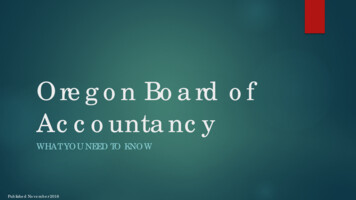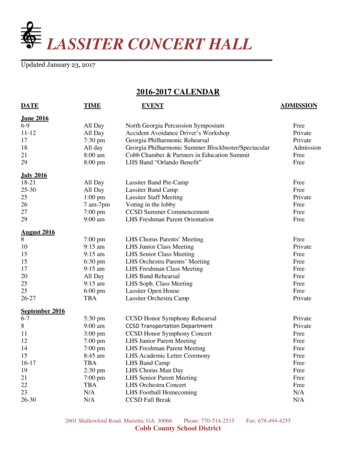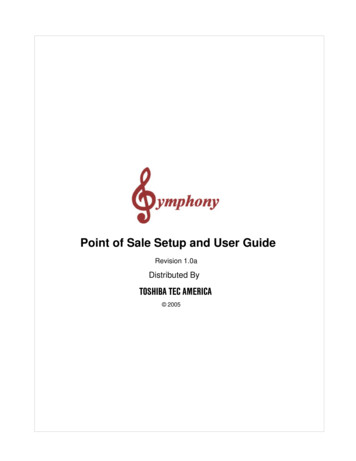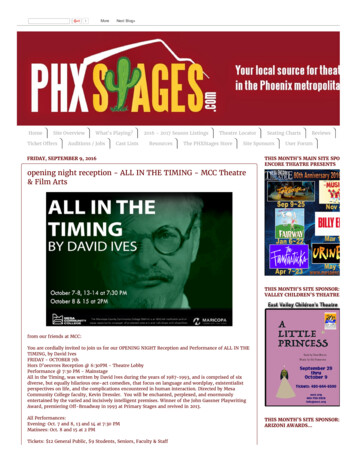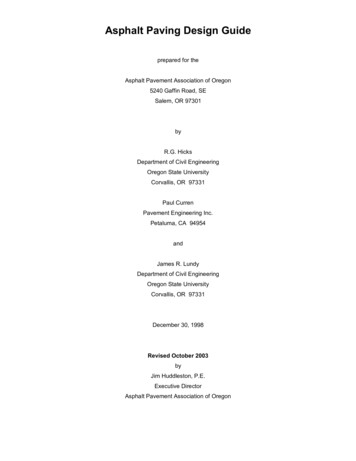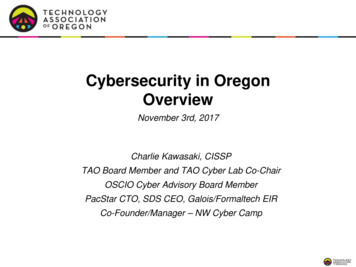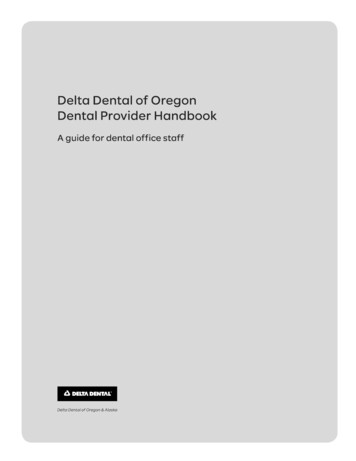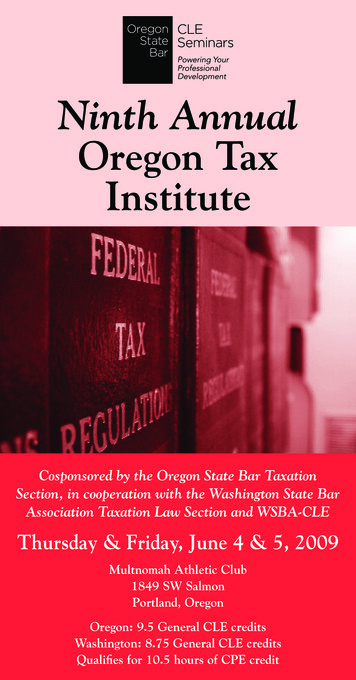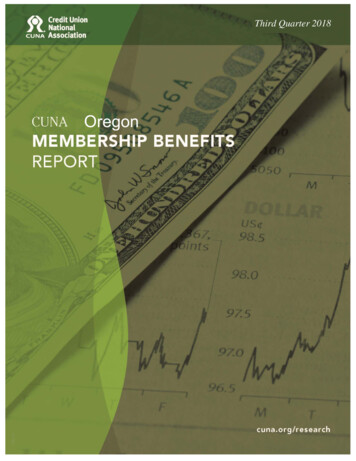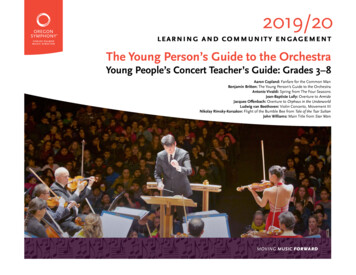
Transcription
2019/20learning and community engagementThe Young Person’s Guide to the OrchestraYoung People’s Concert Teacher’s Guide: Grades 3–8Aaron Copland: Fanfare for the Common ManBenjamin Britten: The Young Person’s Guide to the OrchestraAntonio Vivaldi: Spring from The Four SeasonsJean-Baptiste Lully: Overture to ArmideJacques Offenbach: Overture to Orpheus in the UnderworldLudwig van Beethoven: Violin Concerto, Movement IIINikolay Rimsky-Korsakov: Flight of the Bumble Bee from Tale of the Tsar SultanJohn Williams: Main Title from Star Wars
WelcomeIntroductionConcert Program (To listen, click the title)How To Use This GuideThis guide is designed to accompany the 2019/20 Young People’s Concert,“The Young Person’s Guide to the Orchestra.” We offer backgroundinformation on the pieces you will hear at the concert, along with a listeningguide for each piece, biographical information about the composers, andextension activities for further study.Also included are introductions to the four families of instruments(strings, woodwinds, brass, and percussion) and online resources. It isour hope that utilizing this guide will deepen the concert experience foryour students. We encourage you to fit this material into your teaching styleand specific student needs.Providing this guide online allows teachers to project information to theentire class and access listed websites in the resource section. All materialsare developed to help meet and exceed the Oregon Department ofEducation’s Arts Content Standards curriculum objectives, and CommonCore standards, and to support your work in the classroom.Concert Theme: “The Young Person’s Guide to the Orchestra”Norman Huynh, associate conductorPam Mahon, narratorAaron Copland: Fanfare for the Common ManBenjamin Britten: The Young Person’s Guide to the OrchestraAntonio Vivaldi: Spring from The Four SeasonsJean-Baptiste Lully: Overture to ArmideJacques Offenbach: Overture to Orpheus in the UnderworldLudwig van Beethoven: Violin Concerto, Movement IIINikolay Rimsky-Korsakov: Flight of the Bumble Bee from Tale of the Tsar SultanJohn Williams: Main Title from Star WarsGoals of the Teacher’s Guide usage and concert attendance: Introduce students to live orchestral music. Provide students with an opportunity to participateas audience members in the live music experience. Introduce students to all of the instruments and how theyexpress particular musical ideas. Demonstrate the role of music in various art formsthroughout program selections. Introduce students to the classical music genre, its composers,its place in the historic context, and its evolution to date. Encourage students to critique selections listening forimages suggested by the composers music.The Oregon Symphony believes that music is an essential part of thetotal school curriculum. We hope you will take full advantage of thisguide and hyperlinks so your students in turn can be knowledgeable andeager participants.Please email us at educate@orsymphony.org if you have questionsor wish to share your experiences in preparing your students for ourYoung People’s Concert.Monica Hayes, M.S. Ed.,Hank Swigert director, learning & community engagement programs2019/20 Young People’s Concert: The Young Person’s Guide to the Orchestra2
WelcomeGuide ContentsPage 2 Introduction, Concert Details, Listening Links,and Concert GoalsPage 3Guide ContentsPage 4National & State Content StandardsPage 5 Sound Awareness and Concert ExpectationsPage 6Resources on the WebPage 7 Meet Conductor Norman HuynhPage 8 Biographies of Kaia Selden and Pam MahonPage 9Getting to Know the OrchestraPage 10 The Orchestra by the NumbersPage 11Brief History of the Oregon SymphonyPage 12 Brief History of the Arlene Schnitzer Concert HallPage 13 Concert Program Notes, Biographies of Composers,Extension ActivitesAppendixPage 30 Instrument Families in the OrchestraPage 34 Oregon Symphony RosterPage 35Blackline Images of Instruments and OrchestraPage 40 Our Generous Education Program Supporters2019/20 Young People’s Concert: The Young Person’s Guide to the Orchestra3
Curriculum ConnectionsNational & State Content StandardsThe Oregon Symphony has an ongoing commitment to supportthe National Standards for Music Education as outlined below:In addition, this Young People’s Concert supports the followingCommon Core State Standards:1. Performing on instruments, alone and with others, a variedrepertoire of music.The Arts: Create, Present, Perform – Apply ideas, techniques and processesin the arts.2. Reading and notating music. Apply artistic elements and technical skills to create, present, and/orperform works of art for a variety of audiences and purposes.3. Listening to, analyzing, and describing music.4. Evaluating music and music performances.5. Understanding relationships between music, the other arts,and disciplines outside the arts.6. Understanding music in relation to history and culture. Communicate verbally and in writing, using knowledge of the arts todescribe and/or evaluate one’s own artwork.The Arts: Aesthetics and Art Criticism – Respond to and analyze works of art,based on essential elements, organizational principles, and aesthetic criteria. Use knowledge of technical, organizational, and aesthetic elements todescribe and analyze one’s own art and the art of others. Respond to works of art, giving reasons for preferences.The Arts: Historical and Cultural Perspectives – Understand the relationshipof works of art to their social, historical and cultural contexts, and theinfluence of the arts on individuals, communities, and cultures. Understand that the arts have an historical connection. Explain how a work of art reflects the artist’s personal experiencein a society or culture.Download the most current version of Oregon’s Common musicfrom the Department of Education’s website.2019/20 Young People’s Concert: The Young Person’s Guide to the Orchestra4
WelcomeConcert ExpectationsSounds Awareness ActivityConcert DayWe are constantly surrounded by sound, but rarely do we truly listen towhat we hear. Listening to a 50-minute concert may be a new and unusualexperience for many of your students. Essential to the development of deeplistening skills is the acquisition of sound awareness. Following are somesuggested strategies for developing active listening skills in listeners of allages. These exercises will be helpful prior to any of the following lessonsas you introduce the music and concepts found in this Teacher’s Guide.The day of your Young People’s Concert experience is sure to be a funand exciting one. Knowing what to expect will help you and your studentsprepare for the concert and will make the experience the best it can be.Listed below are a few logistical details along with some basic expectationsthat we have of concert attendees.Arrival & Seating InformationInstructional ActivitiesTwo weeks prior to the concert date you will receive a seat confirmation foryour group. Bring this with you on the day of the concert. For those comingto the Portland concerts, please note on your confirmation your entrancelocation (either the Broadway Street or Park Street entrance) and the sectionin which you are seated. When you arrive at the hall please proceed directlyto the entrance noted on your confirmation. An usher will greet you and leadyou to your section. Groups will be seated front to back on a first-come, firstseated basis. If you arrive together, your group will be seated together. Pleasearrive 30 minutes before the concert start time. Concerts must begin on time.No student backpacks, food, drink, or gum will be allowed in the concert hall.If you plan to bring lunches, please store them on your bus or in the lobby.Use of cell phones and cameras is prohibited during the concert.Environmental SoundsConcert Expectations Turn off the classroom lights and have students close their eyes.Please take a few moments before the concert to discuss with your studentsand chaperones your expectations for their concert behavior. Young People’sConcerts are designed to be informative and entertaining. We encouragekids to move to the music and show that they are having a good time byapplauding and participating at appropriate times. Please remind yourstudents to respect fellow audience members by refraining from conversationthroughout the concert, just as they would be asked in an assembly attheir school. The best way to show the performers that they are enjoyingthe concert is by listening quietly during the performance and clappingenthusiastically after each piece.GoalStudents will develop active listening skills.Instructional ObjectivesStudents will: Identify and describe environmental sounds. Identify and describe various sounds played ona variety of musical instruments. Have students spend one full minute listening to environmental sounds. Elicit responses from students as to what sounds they heard. Create a wordbank using all student responses. After an initial list has been created, go back to each sound on the list andask students to describe their sound further. Add these descriptions to eachsound listed. Refer back to this word bank throughout the year, adding sounds anddescriptions to increase sound awareness.2019/20 Young People’s Concert: The Young Person’s Guide to the Orchestra5
Resources on the WebInteractive Music Resources – Websites for Kids & TeachersOregon Symphony Education Resources: Links to materials related toorchestra sections, and more.Sphinx Kids: A website that includes games, videos and music, with a specialfocus on minority composers and musicians.Oregon Symphony: Learn all about the musicians, plus a guide to theinstruments of the orchestra.Carnegie Hall Weill Institute Resource Center: A website with a musiceducators’ toolbox.Classics for Kids: Award-winning interactive programs with classroomactivities, games and historic information.History of the Orchestra: A website with the history of the orchestra.Dallas Symphony for Kids: A national award-winning website to get studentsand teachers more involved in classical music.Lesson ideas from Teacher’s Institute SFSO: A website with lesson ideas.New York Philharmonic for Kids – “Kidzone”: A website with interactivegames, music, classroom activities, information about classical music and funfacts about music composition.2019/20 Young People’s Concert: The Young Person’s Guide to the Orchestra6
The Young Person’s Guide to the OrchestraMeet our ConductorNorman Huynhoregon symphony associate conductorNorman Huynh has established himself as aconductor with an ability to captivate an audiencethrough a multitude of musical genres. Thisseason, Norman continues to showcase hisversatility in concerts featuring Itzhak Perlman,hip hop artists Nas and Wyclef Jean, and vocalsuperstar Storm Large.Born in 1988, Norman is a first generation AsianAmerican and the first in his family to pursueclassical music as a career. Upcoming and recentengagements include the St. Louis Symphony Orchestra, Detroit Symphony,Grant Park Music Festival, and the Princess Galyani Vadhana YouthOrchestra of Bangkok. He has served as a cover conductor for the New YorkPhilharmonic and Los Angeles Philharmonic with John Williams.Norman has been at the forefront of moving orchestral music out of thetraditional concert hall. In 2011, he co-founded the Occasional Symphonyin Baltimore to celebrate holidays by performing innovative concerts indistinct venues throughout the inner-city. The orchestra performed on Dr.Seuss’ birthday at Port Discovery Children’s Museum, Halloween in a burntchurch turned concert venue, and Cinco de Mayo in the basement bar ofa Mexican restaurant.Norman currently resides in Portland, or and enjoys skiing, boardgames andriding his motorcycle. You can follow him on Instagram @normanconductor.2019/20 Young People’s Concert: The Young Person’s Guide to the Orchestra7
Young Person’s Guide to the OrchestraMeet our SoloistMeet our NarratorKaia SeldenPam MahonviolinnarratorFourteen-year-old violinist Kaia Selden has receivedfirst prize in several competitions, includingCascades Music Foundation, Simon Fiset andSeattle Young Artists. She was a finalist at the 2018Postacchini International Competition in Italy andreceived third prize at the 2019 Kocian InternationalCompetition in the Czech Republic.Pam Mahon is excited to introduce the audiencemembers to all of the musicians in the orchestraas narrator in Britten’s Young Person’s Guide to theOrchestra. Ms. Mahon is also the teaching artistfor the Oregon Symphony’s Kinderkonzerts andCarnegie Hall Link Up National Concerts.Kaia has performed twice on npr shows: “Fromthe Top” with Christopher O’Riley in Las Vegasand “Tiny Desk Concerts” in Washington, D.C.She made her concerto debut at ten and has since been featured as soloistwith Philharmonia Northwest, Classical Tahoe Festival Orchestra, NorthwestSymphony and Seattle Symphony. This season she will be performing withOlympia Symphony, Kirkland Civic Symphony and Oregon Symphony.Kaia’s first violin lessons were at the Community Music Center in Portland, or,where her teachers included Oregon Symphony violinist Clarisse Atcherson.She is currently a freshman at Lincoln High School in Portland and she is aviolin student of Simon James. In her spare time, she enjoys rock climbing,movies, chamber music, and reading Murakami.Other Portland credits include: Lureena Jones,Adrift in Macao (Broadway Rose); Aldonza, Manof La Mancha; Mother, Ragtime; Baker’s Wife, Intothe Woods; Claire Ganz, Rumors; Donna/Oolie,City of Angels; Carmen, Sweet Charity; Pam, The Full Monty (LakewoodTheatre Company); Mary Bland, Eating Raoul (Live on Stage); Madame dela Grande Bouche, Beauty and the Beast; Wicked Witch of the West, TheWizard of Oz; and Brooke Wyndham, Legally Blonde: The Musical (PixieDust Productions); Mazeppa, Gypsy (Portland Center Stage); Young Boy,Jenůfa; Chocholka/Jay, The Cunning Little Vixen; Papagena, The Magic Flute;Nurse Maid, Street Scene (Portland Opera).2019/20 Young People’s Concert: The Young Person’s Guide to the Orchestra8
Young Person’s Guide to the OrchestraGetting to Know the OrchestraIt’s the big day and you take your seat in the concert hall ready to hear someclassical music. You look up and see almost 80 people in the orchestra. Here’sa breakdown of the instruments they’re playing: Bassoon: Looks like a plumbing pipe; sounds like a dream. High notessound throaty, even otherworldly. Middle notes sound luscious, full, mellow;low notes can be very powerful. Violin: The instrument is made of wood; the bow is made of horsehair; thefour strings are made of metal; the sound is sweet, singing, and divine.They’re divided into two sections, First and Second Violins, each withdifferent music to play. French Horn (or just Horn): The most noble-sounding brass instrument;has a full, round, dark tone, great for majestic hunting calls. Viola: Slightly larger than a violin, playing slightly lower notes, with abreathier or throatier sound than a violin. Trombone: A powerful low brass instrument with a slide to change notes.Essential for parades, as well as symphonies. Cello: Played sitting down, with the instrument between the legs. Makes abeautiful, rich, singing sound. Tuba: Lowest of the brass instruments. Can produce a wall of low,blasting sound. Bass (or Double Bass): Enormous, bigger around than the average humanbeing. Plays the lowest notes of all the strings, providing the foundation forthe orchestra’s sound. Played sitting on a tall stool or standing up. Flute: Blown across, just like a bottle; produces a sweet, silvery sound. Percussion: The player is expected to be a master of a vast range of differentinstruments: timpani (the great big kettledrums), bass drum, snare drum(for marches), cymbals (for crashing together), xylophone (played withmallets), and other oddities. Oboe and English horn: Played by blowing into a reed, a whittled-down flatpiece of sugar cane. Produces one of the most beautiful sounds on earth:clear, vibrant, sweet, plaintive, and full. Piano: a musical stringed instrument resembling a harp set in a vertical orhorizontal frame, played by pressing keys that cause hammers to strike thestrings and produce audible vibrations. Clarinet: A dark, tubular woodwind instrument that creates a full, roundsound, very pure, without the edge of the oboe’s sound. Harp: a musical instrument consisting of a triangular frame formed by asoundbox, a pillar, and a curved neck, and having strings stretched betweenthe soundbox and the neck that are plucked with the fingers. Trumpet: The most powerful orchestral instrument and the highest-pitchedbrass instrument. Executes impressive runs and leaps in a single bound.2019/20 Young People’s Concert: The Young Person’s Guide to the Orchestra9
The OrchestraBy the NumbersConductor1Total Musicians 76STRINGSViolins24Violas8Cellos7Double Basses5WOODWINDSFlutesPiccoloOboesEnglish HornClarinetsBassoons313133BRASSFrench cussionKeyboardHarp1311About the OrchestraThe symphonyorchestra is the largestand most exciting ofall musical groups,with as many as 100players. It is dividedinto four musicalfamilies called strings,woodwinds, brass,and percussion. Everyinstrument in theorchestra belongs toone of these families.In a symphonyorchestra, the musicalfamilies are related toone another just likecousins, aunts, anduncles. The orchestrais a big family ofinstruments playingtogether.To learn moreabout your OregonSymphony, check usout online.2019/20 Young People’s Concert: The Young Person’s Guide to the Orchestra10
HistoryBrief History of the Oregon SymphonyThe Oregon Symphony is Portland’s largest performing arts organization today, butit has long and deep roots that go all the way back to 1896 and the founding of thePortland Symphony – the first orchestra west of the Mississippi River. W.H. Kinrossconducted the inaugural concert at Portland’s Marquam Grand Theatre on October 30of that year. By 1899 the Symphony performed an annual concert series, and in 1902 itembarked on its first state tour.The decades that followed saw many milestones, but two of the biggest came in1967 – when the orchestra’s name was officially changed to Oregon Symphony toreflect the increasing number of concerts played outside Portland and a commitmentto serve the larger statewide and regional community – and in 1984 when, under theleadership of Music Director James DePreist, the orchestra moved from the PortlandCivic Auditorium (now Keller Auditorium) to its current home, the Arlene SchnitzerConcert Hall. The move, and DePreist’s leadership, were turning points in the OregonSymphony’s history that resulted in a new level of concert activity, even greater servicein the areas of education and community programs, and recordings.In 2003, when DePreist retired after 23 seasons with the orchestra, Carlos Kalmar tookover as its 10th music director. He continues to lead the orchestra’s 76 musicians tonew heights, including music’s most prestigious concert venue, New York’s CarnegieHall, as part of the first Spring for Music Festival. The orchestra’s newest cd is HaydnSymphonies, released on the Pentatone label. The Symphony’s recorded works reachmillions of music lovers via broadcasting on All Classical and American Public Mediaprograms, and have received Grammy nominations.2019/20 Young People’s Concert: The Young Person’s Guide to the Orchestra11
HistoryBrief History of the Arlene Schnitzer Concert HallThe Arlene Schnitzer Concert Hall is a historic theater building and performing artscenter in Portland, Oregon. Part of the Portland Center for the Performing Arts, it ishome to the Oregon Symphony, Portland Youth Philharmonic, Metropolitan YouthSymphony, White Bird Dance Company, and Portland Arts & Lectures. The OregonSymphony is the main tenant in this city-owned building, renting the hall for allrehearsals and performances. Originally (and sometimes still referred to as) theParamount Theatre, it is also locally nicknamed “The Schnitz”.It is the last surviving theater building on Portland’s Broadway, which was once linedwith large theater houses. The architectural firm Rapp and Rapp, famous for itstheater buildings, designed the Italian Renaissancestyle building. The building was variously described bythe newspapers as being of the French Renaissanceor Northern Italianate style. The Paramount wasconsidered, at its opening, to be the largest andmost lavish theater for a city the size of Portland.Originally opened as the Portland Publix Theatre, avaudeville venue in March 1928, the name changed tothe Paramount Theater in 1930, as the owners had acontract to run Paramount films locally. The buildingcontinued to show films until 1972, after which ithosted rock concerts.Visitors were greeted by a 65-foot (20 m) high“Portland” sign above the Broadway Marquee, whichcontained approximately 6,000 theatrical lights. Thecurrent sign is an exact replica of this original sign. Thesign read “Paramount” from 1930–1984. The theaterwas designed with many foyers and lobbies. The mainentrance to the auditorium boasted huge French-panedwindows facing east and south, covered with velvetdrapes. The walls were covered with mirrors and marble,and the floors were covered with expensive carpets.The furnishings had been purchased from a Frenchmuseum and private collections. The concessionsstand was made of marble and stretched nearly halfthe length of the main lobby. It was described as the“longest candy counter in the West.”The lobby was lit with huge crystal chandeliers. Nearly 35,000 had been spenton them. The largest had a span of nearly 8 feet, weighing over 1700 pounds andcontaining 181 lights. Currently, the largest chandelier has 137 candle bulbs, and thesmaller ones each have 124 bulbs.In 1972, the Portland City Council voted to give the building Landmark Status, over theobjections of John Haviland, the owner. The landmark status applied only to the exteriorof the building. Many people felt that the interior of the building was more valuablearchitecturally. The building (as the Paramount Theatre) was placed on the NationalRegister of Historic Places in 1976. In the 1970s Haviland wanted to either sell or renovatethe building as it was coming into disrepair and theconcert goers were ruining the interior. The originaltheater organ and statuary were sold off in an auctionon March 26, 1975. During the auction, there was ageneral outcry from the audience to keep a particularmarble statue, called “Surprise” (a nude girl with herhands thrown across her face) in the theater. A hat waspassed among the 1200 member audience to take upa collection, and 5,233.97 was raised to purchase thestatue and keep it in the theater lobby. The statue had afinger missing from a bullet from a box-office robbery inthe 1920s, it is now restored. “Surprise” still greets allvisitors to the hall in the main foyer.A major renovation began in September 1983 to thedesigns of Boora Architects, restoring the buildingto much of its original opulence. The interior of theauditorium, however, was painted one neutral color,rather than restoring the murals that had decoratedit. Portland residents Arlene and Harold Schnitzercontributed generously to the completion of the initialphase of the Portland Center for the Performing Arts.The one-year, 10 million renovation involved repairing,recasting or replacing much of the theatre’s ornateinterior as well as making it comfortable and safe fortoday’s audiences and performers. It is a gem in ourcity and we are happy to welcome you into the OregonSymphony’s home!2019/20 Young People’s Concert: The Young Person’s Guide to the Orchestra12
The Young Person’s Guide to the OrchestraComposer and Program NotesComposer: Benjamin BrittenBorn: November 22, 1913, Lowestaft, EnglandDied: December 4, 1976, Aldeburgh, EnglandThis Oregon Symphony Young People’s Concert features Benjamin Britten’scomposition, written expressly to introduce students to the instruments andsections of the orchestra. Get to know it well and you will be pleased withthe connection your students will already have with the concert experience,as they settle in for this well-planned program of iconic music.To conclude the work, Britten wrote his own brisk and lively fugue subject,which is in itself a variation on Purcell’s theme. The piccolo starts, and allthe instruments or groups of instruments enter in the order in which theywere heard in the variations. With all the instruments playing together, thecomposition comes to a grand climax when the brass sound the originalPurcell theme.The work was dedicated to the children of the Maud family, with whom thecomposer had become friends.About Benjamin Britten’s “Young Person’s Guide to the Orchestra”Britten wrote Young Person’s Guide to the Orchestra in 1946 as part of the scoreto a documentary film designed for children in 1946 for a British Ministry ofEducation film entitled Instruments of the Orchestra. The piece begins withthe full orchestra playing a sweeping, stately theme based on the Rondeaufrom Abdelazar composed by Henry Purcell in 1695, the final year of his life.Britten then briefly introduces each section of the orchestra: woodwinds,brass, strings, and percussion and each play their own variation on the theme.Next, Britten produces a veritable Who’s Who of the full orchestra. Eachinstrument is provided an ingenious variation that both stresses thatinstrument’s particular characteristics and demonstrates how it is typicallyused within the orchestra.2019/20 Young People’s Concert: The Young Person’s Guide to the Orchestra13
The Young Person’s Guide to the OrchestraListening NotesBritten: A Young Person’s Guide to the OrchestraThe Young Person’s Guide to the Orchestra composed by Britten in 1946,is based on a theme from Abdelazar written by Henry Purcell in 1695, andis played by the entire orchestra at the beginning, and then is scored forindividual sections at a time: first the woodwinds, followed by the brass, thenthe strings, and finally with an interpretation played by the percussion.After this introduction to the different families of the orchestra by repetitionsof the theme, there is a more in-depth look at the different instrument familieswith variations on the theme played by individual instruments. Although itstarts by featuring the piccolo and flutes, the underlying harmonic structure ismaintained by the harp and strings. Each member of the woodwind family isthen introduced in turn, highlighting the unique sound of each instrument.Follow along as you watch and listen to this performance. Each instrumentin each section is brought into the theme! The piece is 16 minutes and 48seconds and well-worth listening to and watching several times prior toattending the Oregon Symphony concert. See if students can close their eyesand recognize each instrument joining in on each variation. Benjamin Brittenwrote this piece specifically for students to listen, learn and be inspired to play.Theme: Allegro maestoso e largamenteVariation a: Presto – Piccolo and FluteVariation b: Lento – OboesVariation c: Moderato – ClarinetsThis format is then copied by the strings in turn, and then by the brass andpercussion, traveling through their individual variations.Variation d: Allegro alla Marcia – BassoonsAfter the whole orchestra has been taken in pieces, it is reassembled using anoriginal fugue which starts with the piccolo, followed in by all the woodwinds,strings, brass and percussion in turn. Once everyone has entered, the brassare re-introduced with Purcell’s original melody while the remainder continuethe fugue theme until the piece finally comes to an end after building up to afortissimo finish.Variation f: Meno mosso – ViolasVariation e: Brillante: alla polacca – ViolinsVariation g: – CellosVariation h: Cominciando lento ma poco a poco accel. al Allegro – BassesVariation i: Maestoso – HarpVariation j: L’istesso tempo – HornsVariation k: Vivace – TrumpetsVariation l: Allegro pomposo – Trombones and tubaVariation m: Moderato – PercussionFugue: Allegro molto – each section enters into the fugue to end with theentire orchestra – finishing as they began!2019/20 Young People’s Concert: The Young Person’s Guide to the Orchestra14
The Young Person’s Guide to the OrchestraExtension ActivitiesBritten: A Young Person’s Guide to the OrchestraActivityPreparation/Materials Divide the class into four groups. Assign each group a family of instrumentsto research and present to the rest of the class. Information should includehow the family of instruments is designated, and a list of instrumentsincluded in the family. If possible, students will play recordings of the familyof instruments or individual instruments in the family. Computer and projector to show a map of the sections of the orchestra:“The Orchestra” page in this Teacher’s Guide If students have access to individual computers, or can pair up: class set ofcomputers with headphones If a class set of computers is not available, print out several of each page fromthe Appendix of this Teacher’s Guide: “String Family,” “Woodwind Family,”“Brass Family,” and “Percussion Family.” It may also be helpful to have severalprintouts of “The Orchestra” and “Getting to Know the Orchestra” If computers are not available for students to play recordings, teacher willplay recordings of instruments using the links below: Oregon Symphony’s website page about the instruments Philharmonia, a website to explore instruments Dallas Symphony Orchestra website to learn and listen to instruments2019/20 Young People’s Concert: The Young Person’s Guide to the Orchestra15
The Young Person’s Guide to the OrchestraComposer and Program NotesComposer: Aaron Coplandthe Common Man because he wanted to honor every person who workedfor victory, including those who weren’t
2019/20 learning and community engagement The Young Person’s Guide to the Orchestra Young People’s Concert Teacher’s Guide: Grades 3–8 Aaron Copland: Fanfare for the Common Man Benjamin Britten: The Young Person’s Guide to the Orchestra Antonio Vivaldi: Spring from The Four Seasons Jean-Baptiste L

